Back on the Road Again Bass
Throughout the Beatles' 8 years of recorded content, the band reinvented songwriting and demonstrated a tremendous breadth of musical creativity during such a short period of time. The band recorded everything from show tunes to ballads, songs inspired by Motown, songs inspired by the birth of rock in the 1950s, ballads, blues pieces, R&B to brain-twisting psychedelic, and even more all while blazing the path for with new recording techniques and pushing the envelope for what was possible in to record in the studio.
Over all these musical changes, Paul McCartney adapted and showed his ability to create some of the gold-standards of bass playing regardless of what the song could be boxed into as a genre. McCartney could play simple root and fifth lines like on "Love Me Do," "From Me to You," and "One After 909", rock 'n' roll eighth notes like on "I Saw Her Standing There," "Long Tall Sally," and "Little Child", bass lines that pushed the song forward like on "Get Back," "Everybody's Got Something to Hide Except Me and My Monkey," and "I'm Down", short repetitive grooves "Taxman," "Dr. Robert," and "Come Together", and even fast and flashy lines ("Rain," "Paperback Writer," "I Want You (She's So Heavy)").
But Paul was probably known best for his ability to craft melodic bass lines or bass lines that move through the chord changes rather than change with them as they come and works to smooth over the entire song. Using arpeggios and scalar passages, McCartney was among the first bass players in the forefront of modern rock music to
Of course, Paul McCartney was a natural melodist, having written some of the most memorable songs in the history of popular music. In this article, we'll look at a few of McCartney's most melodic electric bass passages and focus on some common patterns that he used to connect chords.
Here's a breakdown of 20 of the quintessential Paul McCartney bass lines:
1. "Taxman" – Revolver (1966)
If there was a more recognizable Beatles bass line, it can't beat out "Taxman".
McCartney's bass work here is very straightforward but very distinct and certainly can be argued to be the melodic element of the song. As George and John alternate between downstroke guitars on beats 2 and 4 throughout the verse, chorus and guitar solo sections, McCartney is keeping to the mid-to-upper register of the bass guitar to build out this bass line.
The most interesting aspect of this bass line is it's simplicity. The line's first pattern begins first on the chord's root note D on the 5th fret and jumps to the octave D on the 7th fret on the G string. Then, it incorporates a hammer on on the D string from G to A and resolves back towards the high C.
This pattern is held until McCartney drops it down to start on A natural on the corus and then down lower to begin on the G for the second part of the chorus.
While McCartney's root notes stay in line with the chord changes of the song, the pattern of notes and bass line's rhythm stay consistent wherever Paul is playing the line on the neck.
2. "Something" – Abbey Road (1969)
Few bass lines best capture McCartney's melodic style of playing than the line played on "Something" off the Beatles' 1969 release, Abbey Road.
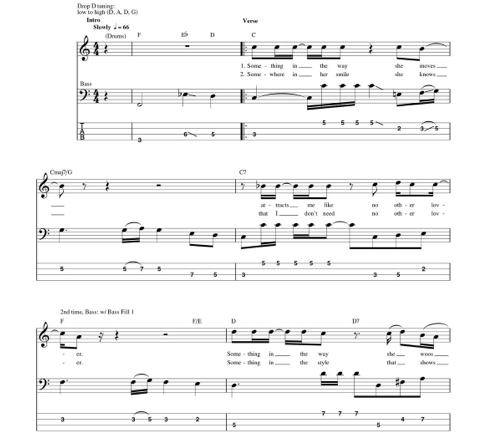
This first figure (left) outlines a section of the verse and the bass line McCartney plays on it.
Immediately, someone looking to learn this line can see that the bass very often completes the vocal melody and the spaces where the guitar playing is at it's least. Best shown on measure 3, measure 5 just before "Something in the way…", measure 7 and 8to name a few sections.
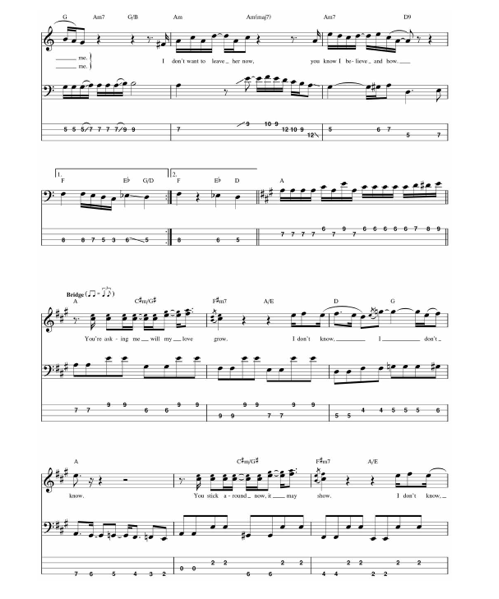
In the verses of "Something", Paul focuses his work on completing and complimenting the endings of Harrison's passages. Every 2-4 bars, McCartney is right there usually with a very distinct 16th note run to punctuate the phrase or with a half or quarter note series that sounds and resonates distinctly differently from the delicate comping guitars of Harrison and Lennon.
Moreover, Paul tends to begin his bass lines on the root notes of the chords being played but winds through the chord into the next one.
It's this quality that makes a McCartney bass line so distinct: his ability to wind and weave through chords both by combining note selection with rhythmic distinction from the rest of the instruments playing. Moreover, it's a theme that I'll refer back to over the course of this post because the trait is just that apparent.
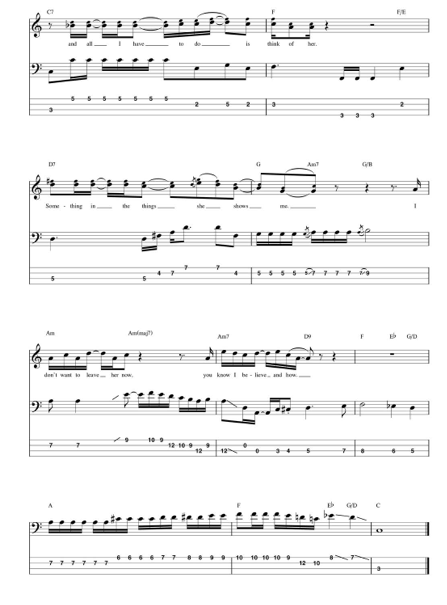
The bridge of "Something" is particularly interesting from a listener's standpoint as well as from an observational perspective when looking at the sheet music.
The first thing that stands out is just how busy the bass line is compared to the guitar work. The bridge is a fantastic example of Paul taking the musical lead with the bass while still moving in step with the chord progression created by Harrison.
Whats more, McCartney is very generous with accents and annunciations during the bridge. Slides, hammer-ons and drops and jumps from one octave to another are very common here and only add to the lead qualities mentioned before.
As Harrison's vocals soar and reach a climax before entering the guitar solo, McCartney is right there behind him with a scalar run of 16th notes (see the last 3 measures above) before dropping off with a low C – a musical period on this section of "Something" because of it's distinctness from the rest of the bass line up to this point and from a song structure stand point. The bridge is now over – time to enter the guitar solo.
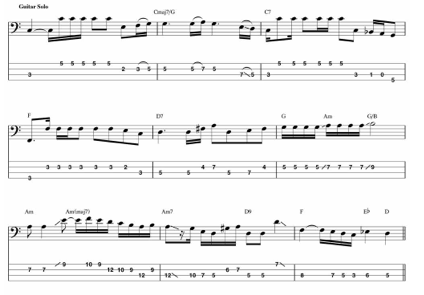
The last major point is the guitar solo of the song through to the end.
McCartney revisits the bass theme established during the verse but this time with a few variations including using more scalar runs to connect chords and bars together. A good example of this is the 7th measure of the guitar solo section (see right) where beats 3 and 4 are connected by a series of 16th notes running down an E minor scale across an Amjr7 chord back into an Am chord in the next bar.
3. "While My Guitar Gently Weeps" – The White Album (1968)
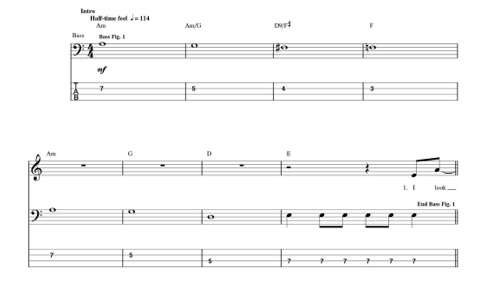
Unlike McCartney's work on "Something", Paul's bass work on George Harrison's classic, "While My Guitar Gently Weeps" takes on more of a "traditional" bass guitar role, aimed at providing bottom end and structural support to Harrison's song.
The introduction of "While My Guitar Gently Weeps" showcases Harrison's guitar work while McCartney provides whole notes
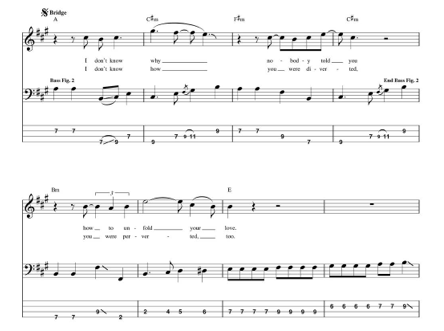
McCartney's playing is showcased most during the bridge of this song. While the sounds of a Hammond organ provide a background of chords behind Harrison's singing, McCartney meshes aspects of a walking bass line together with slides and accent patterns to continue to give the song a forward moving feeling with a bit of weight to it.
Listening the recording, the most stand-out notes that McCartney plays during the bridge section are in the first measure of the bridge where Paul will jump down from the high A to the B natural and build back up the scale starting at B to A, then to E, back down to A and build back up across the first 2 measures of the section.
This pattern re-emerges on in the 5th bar when on beats 1 and 2, Paul starts on a B natural, jump to an F on beat 3 and slides down to D on beat 4 and rebuilds back up through bar 6 then resolves then entire passage across bars 7 and 8 and leads into the verse (below) where Paul returns to rhythmic playing.
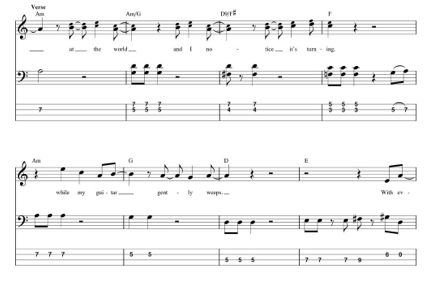
Paul's playing on "While My Guitar" sticks to filling a supportive role rather than a melodic role.
The pattern to the left is the theme consistent throughout the verse: accented playing on beats 1 and 2 of each bar and a turnaround on bar 8.
Though there are variations on this theme as the verse progresses for it's full duration, this theme re-emerges as well during Harrison's first guitar solo and on the outro guitar solos as well (both figures below):
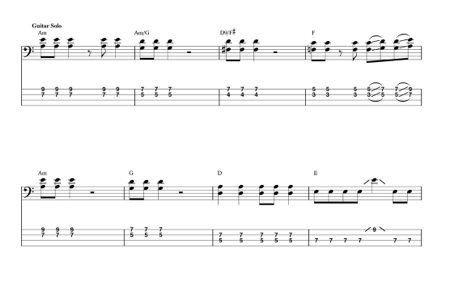
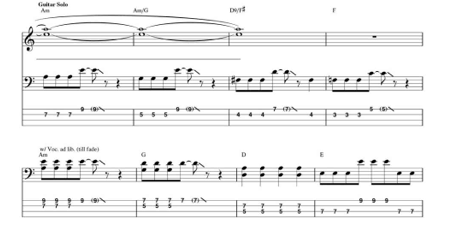
The song, as whole is an excellent showcase of Paul McCartney's more supportive role as a bass player rather than as a melodic, lead. A part – as we'll see throughout this analysis – that he can perform just as well as well as when he is taking the lead.
4. "Come Together" – Abbey Road (1969)
Just as recognizable as "Taxman", "Come Together" is another example of a simple yet incredibly hook-y Paul McCartney bass line. Though some argue that this was his best bass line (but at the end of the day, everyone has a "best Paul McCartney bass line" they can point to), this line is certainly one of the more memorable and a great learning tool for a beginner bass player.
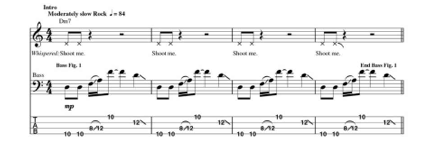
Like "Taxman", Paul's bass line for "Come Together" follows one primary theme (that doo-do-doda-bwahh-doo) that he establishes within the first 4 bars of the song (left)
The song instantly hooks your ear because of all the contrast going on. What do I mean?
- The number of notes being played in the phrase. Guitars are largely absent and Ringo's drum part is very minimal – hi hats and light percussion only. Meanwhile, Paul is playing in the upper register of the bass AND working in a (relatively speaking) busy bass line
- The number of accents. Tying into the last bullet point, Paul's use of accents here – slides and hammer ons in particular – further distinguish the line from the rest of the song in conjunction with the points made from the bullet point above.
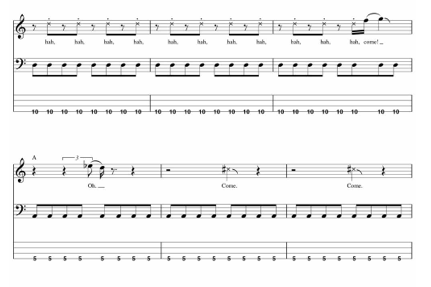
The chorus here is a classic example of a catchy sing along chorus that the music supports wholeheartedly from the all instrument arrangements.
Paul's bass line here is just as straightforward and complimentary: pedaling eighth notes that move in lock-step with the chord changes.
The line here is simple yet functional and designed to be complimentary and rhythmic rather than melodic and independent.
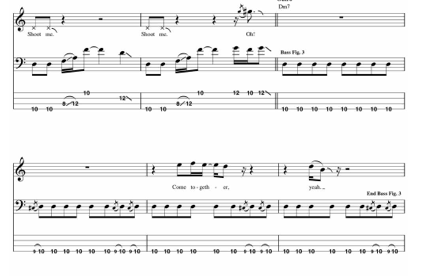
The outro of "Come Together" marries the theme from the intro and verse with the theme from the chorus with a small variation: the inclusion of hammer ons through to the end of the song.
The hammer ons in this example add the same qualities that the accents and note jumps made in the main theme of the song: to add a distinguishable quality from the guitar lines to the bass line.
5. "Hello, Goodbye" – Magical Mystery Tour (1967)
"Hello Goodbye" is a Beatles song off their 1967 album, Magical Mystery Tour. The song itself marries a whimsical song writing style characteristic of the mid-1960s Lennon/McCartney writing style as well as elements of "simple song" writing of the 1950s love songs and Beach Boys pieces.
"Hello Goodbye" is a great example of a McCartney bass line that picks up steam in select areas of the the song for brief periods of time. Rather than an entire theme being the center point of, say, the verse or the bridge, it's 4 bar runs that make the song a noteworthy piece in this list.
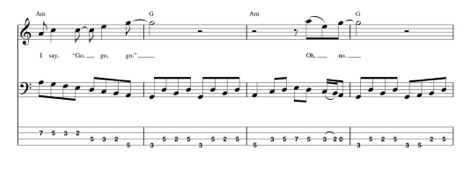
The case that I'm referring to are the last 5 bars of the verse section of the song, where Ringo begins to outline the backbeat of the song before leading into the chorus ("Hello, hello, I don't know…")
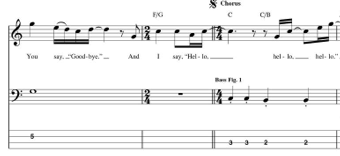
These 5 bars are the bars that drive the song in and out of the chorus and give the song itself a very distinct feeling of movement for a short period of time.
Before and after this part, the song takes on a very carefree and floating quality supported by Lennon's characteristically airy vocals, a mid-range piano hammering eighth notes and Paul's bass line only serving root functions through a quasi-walking bass line and parts that conclude the musical passage every 4 or 6 bars.
I say quasi-walking bass line because the bass line itself does not stay a walking bass line for more than a few bars at a time before breaking to hold for a whole note or to make a short eighth note run to – again – resolve the musical passage (below):
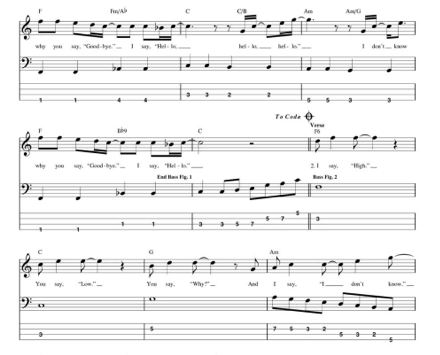
6. "Happiness Is A Warm Gun" – The White Album (1968)
Jeez – what a song this one is!
"Happiness is a Warm Gun" off the Beatles' 1969 self titled double album (affectionately called, The White Album) is on this list simply for the reason that this song is the best example in the entire Beatles catalog of playing a melodic bass line through a dizzying array of very irregular time changes.
If ever there was a better crash course in reading and counting rapid time signature changes than this song, I can't think of one.
Here's a short overview of exactly how many time signature changes go on over the course of this song courtesy of the Beatles Bible:
- 4 bars of 4/4
- 1 bar of 4/4
- 1 bar of 2/4
- 5 bars of 4/4
- 1 bar of 5/4
- 1 bar of 4/4.
- 22 bars of 3/8)
- Three times through a bar each of 9/8 and 10/8
- 4 bars of 4/4
- 3 bars of 12/8 (with the drums doing 4 bars of 4/4 and 1 bar of 2/4)
- 5 bars of 4/4 (the final bar entering free time)
- 1 bar of 2/4 (in free time)
- 5 bars of 4/4
Wow…
I'll give you a minute to check out all those time changes one more time.
In one song, the Beatles gave the entire progressive rock movement of the 1970s a run for their money.

Within the first 8 bars of the song, there is already a time signature change from 2/4 to 4/4 – specifically on bars 6 and 7 (pictured above). Though the bass line appears challenging, Paul is simply playing quarter notes across the chord changes of D minor (not shown – but happens 1 bar before the change to 2/4) and Am, beginning on the root note and then moving down a perfect 4th in measure 6 and measure 7, then moving back up a 4th to the A.
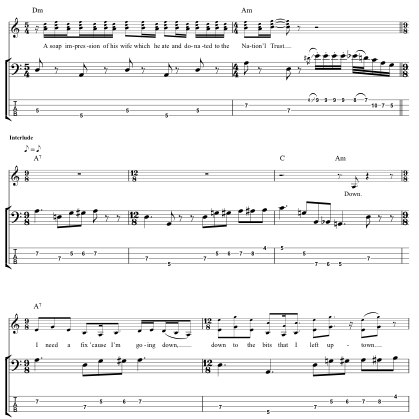
This next excerpt is only 2 more bars into the song from the last excerpt. Like the passage before, Paul's bass line is providing more of a framework to keep time with rather than to create a melodic tool with.
McCartney is returning to using walking bass line qualities beginning on the root note of the bar's chord and only using a handful of notes each time the time changes to a signature too irregular to become melodic or counter melodic with.
Even when the time changes again from a quarter note based feel (5/4, 4/4) into an eighth note based feel (6/8, 7/8, 9/8), McCartney's bass playing stays uncharacteristically controlled, only outlining the downbeats dictated by the time signature, the root note of the chord and only small scalar steps across 3rds and 5ths.
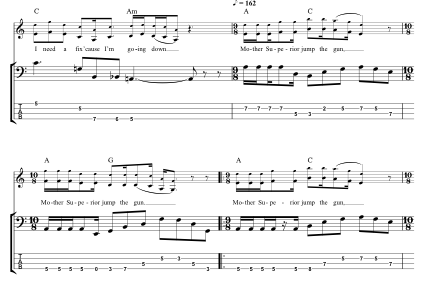
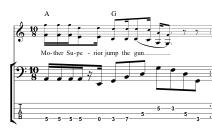
The following passages highlight the back-and-forth between 10/8 and 9/8.
*Before we go any further – a quick counting lesson: 2 16th notes have the same duration as 1 eighth note.
With the first pattern of 9/8, Paul begins playing on an A before dropping down a 5th to the D and then building back up the B major scale into the 10/8 bar.
Transitioning to the bar of 10/8 signifies the addition of only 1 eighth note. This is reflected by McCartney's bass line in these 10/8 bars by playing the exact same bass line as 9/8 but with the addition of the low G at the end of the 10/8 bar (see both bars of 10/8)

The last major section of this song is the chorus where the band returns back to 12/8 time which is another way of counting 4/4.
*Quick counting lesson again! A quarter has the value of 2 eighth notes. So when looking at this bass line and we see a quarter note and an eighth rest, it's counted 1-2-3, 1-2-3, 1-2-3, 1-2-3 | 1-2-3, etc. In other words 12/8 has 4 groupings of 3 eighth notes.
Bearing this counting lesson in mind, Paul's bass line doesn't seem so cryptic.
7. "Lucy In the Sky With Diamonds" –Sgt. Pepper's Lonely Hearts Club Band (1967)
The classic psychedelic epic inspired by a young girl that John Lennon also comes with a bass line that mirrors something Carol Kaye would have come up with.
In the verse of this song, McCartney lays down a foundation of half and whole notes underneath Lennon and George Harrison's guitar work:
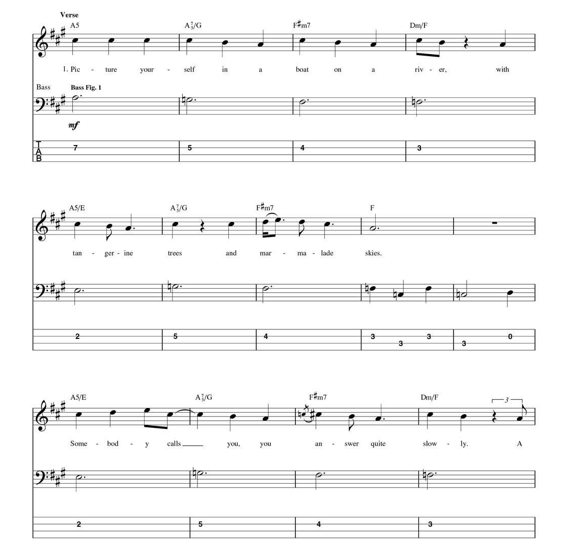
The chord progression is rather straight forward from the perspective of Lennon and Harrison's playing, and to a certain extent, as is McCartney's bass playing.
Through most of these runs, Paul is playing root notes and following along with the guitar part.
It's not until the pre-chorus does Paul whip out a textbook example of a walking bass line.
As the guitar parts and Star's snare match the chugging, predictable feel of the chorus, Paul is weaving through the chords and through the eighth notes with a walking bass line:
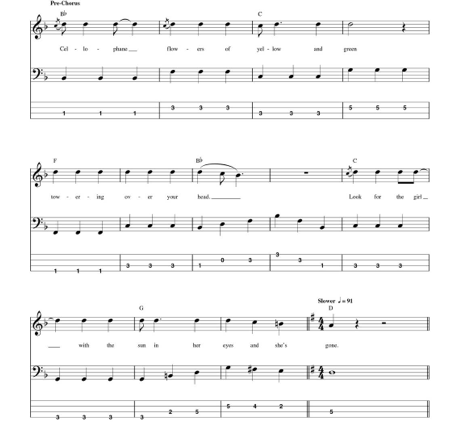 As the song itself builds, so does the complexity of Paul's bass playing.
As the song itself builds, so does the complexity of Paul's bass playing.
As the chrorus unveils and the cymbals are crashing and Lennon is singing, "Lucy in the sky with diamonds/Lucy in the sky with diamonds", Paul is building off of the walking bass line established in the pre-chorus and adding additional "in-between" notes to make it both through the chord progression and from one note to the next, all while providing the melody for the chorus as the guitars provide the rhythm.
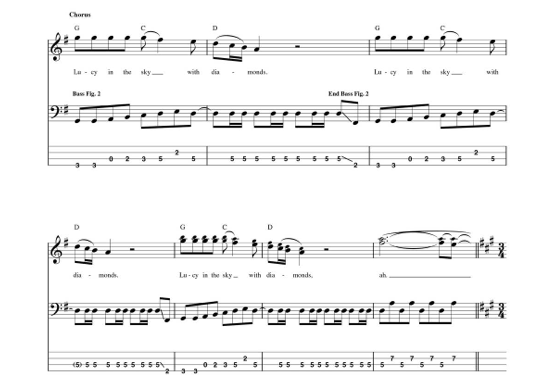
McCartney is very clearly taking advantage of the rests of the guitars on beats 3 and 4 and taking the opportunity to fill those breaks with additional rhythmic support in the form of root notes, scalar runs, slides and bouncing between the root and 5th note of the chord being laid out by Harrison and Lennon.
8. "Hey Bulldog" – Yellow Submarine (1968)
A personal favorite to play, "Hey Bulldog" came out on the 1968 release, Yellow Submarine. This song made it to the list because of the "non-stop-playing" quality of this bass line.
Few McCartney bass lines go on the entire song with few to no rests and this is one of those examples.

Like many of the songs on this list, a major theme or hook is established within the first 4-8 bars of the song, but unlike other Beatles songs mentioned on this list, the introduction of this song establishes gradually builds over the course of 6 bars rather than just repeating in full arrangement. McCartney joins in the theme during the last 6 bars (above)
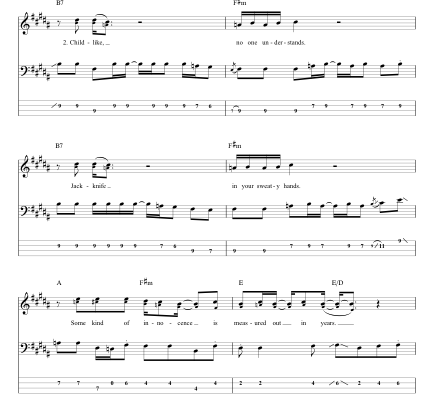
What's also interesting about McCartney's work on this song is that the bass line seldom stops to rest. The bass line continues throughout the song arguably being the sole factor giving the song it's bouncy but moving quality with a combination of eighth note and 16th note runs up and down the chord progression outlined by Lennon and Harrison.
McCartney's bass line also is unique during the verse sections for it's ability to play either in lock step with the eighth note piano in the background of the song and Ringo's hi hat or play in-between them with short 16th note runs, best outlined in each of the measures presented in the excerpt above.
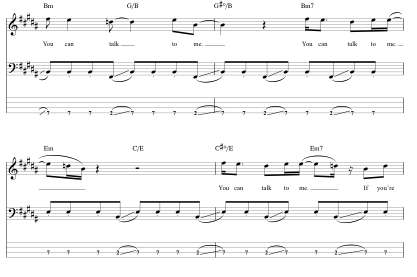
The chorus section (left) is distinct from the rest of the song because of the use of a limited set of notes and the incorporation of slides to move up and down from the low and middle sections of the bass.
During the guitar solos and the outro portions of the song, McCartney revisits playing patterns that were established earlier in the song's verses sections. Like before, the bass lines provide a strong rhythmic undercurrent to the song while Harrison's guitar solo takes place and while the final chorus of the song is being sung taking the song to the conclusion.
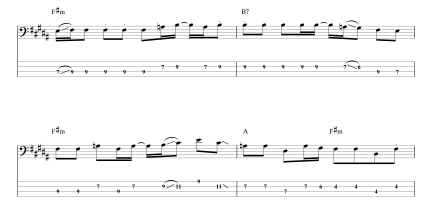
9. "Rain" – single
"Rain" was a single released by the Beatles in 1966 as the B-side to "Paperback Writer", the leading single off the band's 1965 release, Rubber Soul. "Rain" was also one of the first Beatles singles to receive a promotional video release with the song.

It's important to see that "Rain" is only based off of 4 chords:
- G major
- Csus2
- D7sus4
- Gsus4
- Cmaj9
- G7sus4
The latter 4 chords of this song only appear towards the bridge and last chorus briefly. For the most part, the song is based off of 2 chords: G major and Csus2.
Why did I bring this detail up?
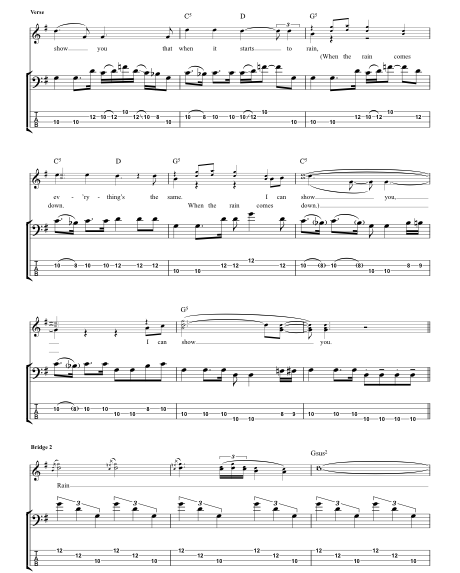
Because these few (and seemingly bizarre, sonically "incomplete-sounding" chords) are what, first, set the sonic backdrop for "Rain" and are what help to make Paul's bass line pop even more.
While the bass line begins each of it's patterns on each of the root notes of the chord, it helps to notice that the vocal melody and the guitar parts are very sparse, very staggered and very winding and psychedelic compared to the bass line which is very flowing in a predictable up-and-down pattern both outlined by how the notes are arranged and how the line actually sounds within the context of the song.
The other portion of this track worth noting is the bridge section. Paul changes up his playing significantly from the theme he established back during the verse, chorus and introduction.
While John, Paul and George all harmonize the word rain and continue to strum G and C chords, Paul is hammering F onto G, harmonizing his bass an octave above the root note of the G when John and George are playing the G major and Gsus4 chord. Moreover, when the chord progression moves through the D and the C major chords (not shown in this excerpt), Paul continues to hammer the high G which ends up harmonizing the perfect 4th of the D chord and the perfect 5th of the C chord.
Yet another of Sir Paul figuring it all out and playing what a great bass player does: what fits and what works for the song.

10. "And Your Bird Can Sing" – Revolver (1966)
"And Your Bird Can Sing" is the last song on this Paul McCartney bass line roundup.
This song was track number 9 on the Beatles' first major step into the realm of psychedelic and world music with their 1966 album, Revolver.

The introduction of this song hits you with full force: a 2 pronged attack of the main theme (later to be revisited during the chorus section) played in unison by Harrison and Lennon while McCartney plays countermelody underneath (pictured above). To give a little bit more perspective how Paul's bass line looks and fits with regard to the descending guitar line, here's what Lennon and Harrison are playing:

Paul's bass line, compared to the guitar line, is significantly less linear and less scalar than the guitar part, but joins the guitars on the eighth notes on beats 3 and 4 in bars 1 and 2.
Lining up each of these eighth notes together creates a very interesting countermelody/melody relationship. Both passages start on a B natural but then separate like this:
Bar 1 – Beat 3 and 4
Bass: B – B – D natural – D sharp
Guitar: F – E – D – E
Bar 2 – Beat 3 and 4:
Bass: B – A – D natural – D sharp
Guitar: G – D – E – F
Bearing in mind that this song is in the key of E (4 sharps; F#, G#, C# and D#), and the chord over McCartney, Lennon and Harrison's parts is an E major chord means that McCartney's bass line harmonizes the perfect 5th, minor 7 and dominant 7th on beats 3 and 4 of the E major chord while the guitars harmonize the minor 2nd, root, minor 7th and root during bar 1 and and the minor 3rd, minor 7th, root and minor 2nd during bar 2.
Ever wonder why the intro to this song sounds to exciting and in-your-face with sound and texture? That's why.
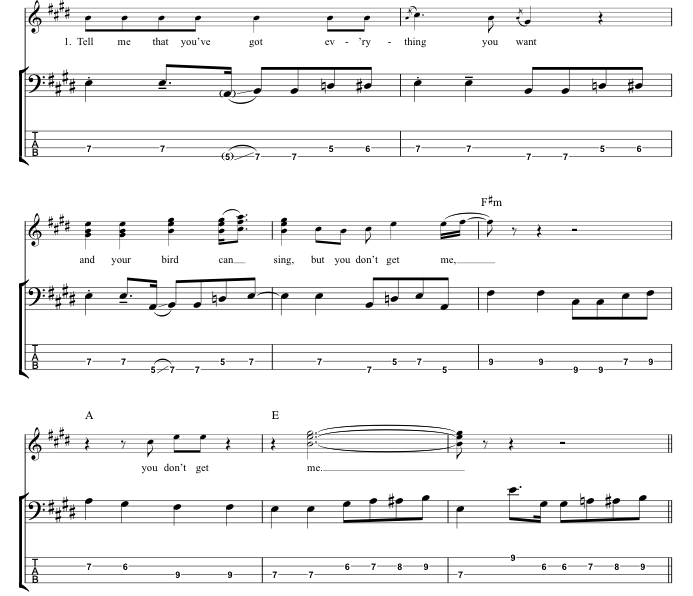
During the verse section, McCartney switches to a quasi-walking bass line,reminiscent of what we touched on during the breakdown of "Hello, Goodbye" above. Either a quarter note passage will fill the space on beats 1 and 2 like in measures 2, 5 and 7 of the above excerpt followed by eighth notes on beats 3 and 4 on the same measures. Other times, McCartney will just play a quarter note on the downbeat of beat 1 usually the root note of the chord followed by a a dotted eighth note-16th note tie into the downbeat of beat 3 like in measures 1 and 3 or one without a tie.
The exception to all of this is measure 6 where the entire bar is a decending scalar quarter note run starting on the A. Listening to the track, this is the part that sticks out clearly and the part that most people will hear without having to actively listen to the track.
Why does this stand out?
Check out the measure. Notice the rests that are in that measure and how much space is left open for the bass to fill. Rather than fill it with a busy flurry of 16th notes that might have jeaprodized the movement and overall feel of the song, McCartney chose to keep with steady, walking quarter notes that fulfill the melodic elements of the song as a whole as well as the melodic elements of this particular part of the song. Smart move.
Conclusion
Whew! So that wraps up my first breakdown of a bass player's (arguably) some of the best bass lines of Paul McCartney.
What did we get from this? Well, McCartney was a pretty smart guy when it came to bass playing. His playing style could best be characterized as melodic, colorful, driving and complimentary. It harkens back to the playing styles of session greats like Carol Kaye and James Jamerson and other RnB bass players who were popular in the United States during the 1950s and 1960s.
Some of Paul's playing is deceptively challenging. "Happiness is a Warm Gun" is a great example of the secret challenge that lies beneath
– – –
Now I want to hear from you!
What did you think? What did I miss? What did I get wrong? Should I do this kind of post again for another bass player?
Shoot me an email at [email protected]
What do you think is a must-know Paul McCartney bass line?
Source: https://smartbassguitar.com/must-know-paul-mccartney-bass-lines/
0 Response to "Back on the Road Again Bass"
إرسال تعليق